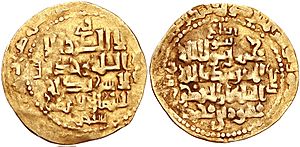Mahmud II (Seljuk sultan) facts for kids
Quick facts for kids Mahmud II |
|
|---|---|

Gold dinar struck under Mahmud II, citing governor Inanch Yabghu. Struck at the Rudhravar mint, dated 1125/6
|
|
| Sultan of the Seljuk Empire | |
| Reign | 1118 – 1131 |
| Predecessor | Muhammad I |
| Successor | Civil war |
| Born | c. 1105 |
| Died | 1131 (age 26) |
| Consort |
|
| Issue |
|
| Father | Muhammad I |
| Mother | Gawhar Khatun |
| Religion | Sunni Islam |
Mahmud II (born around 1105 – died 1131) was a powerful ruler of the Seljuk Empire. He became the Sultan of Baghdad in 1118 after his father, Muhammad I Tapar, passed away. Mahmud was only fourteen years old when he took charge. His rule covered important regions like Iraq and Persia.
Contents
Mahmud II's Reign and Challenges
When Mahmud II first became sultan, he faced many challenges. One of his father's favorite leaders, Garshasp II, lost his good standing. People at court spread rumors about him. This made Mahmud send soldiers to Yazd, where Garshasp was arrested and put in jail. Yazd was then given to the royal cupbearer.
However, Garshasp escaped and went back to Yazd. He asked for help from Mahmud's rival, Ahmad Sanjar. Garshasp's wife was Ahmad Sanjar's sister, which helped him get support. Garshasp encouraged Ahmad Sanjar to attack Mahmud's lands in Central Persia. He also gave him advice on how to march there and how to fight Mahmud.
The Battle of Saveh
Ahmad Sanjar agreed to help. In 1119, he led an army west. He and five other kings defeated Mahmud at Saveh. The kings who helped Ahmad Sanjar were Garshasp II, the leaders of Sistan and Khwarazm, and two other kings whose names are not known. After this victory, Ahmad Sanjar gave Garshasp II his lands back.
Ahmad Sanjar then marched all the way to Baghdad. To make peace, Mahmud had to marry one of Sanjar's daughters. He also had to agree that his uncle, Sanjar, would be his heir. Mahmud was also forced to give up important lands in northern Persia.
Rebellions and Political Moves
In 1120, Mahmud's younger brother, Mas'ud, started a rebellion against him. This civil war ended the next year because of the help of Aqsunqur al-Bursuqi, a powerful leader from Mosul. Mas'ud was forgiven.
In 1126, al-Bursuqi died suddenly. It was believed that Assassins were involved, possibly under orders from Mahmud. In 1127, Mahmud chose Anushirvan ibn Khalid to be his top advisor, called a vizier. But Mahmud removed him from this position the next year.
In 1129, Mahmud officially recognized the power of Imad al-Din Zengi. Zengi had helped Mahmud against a rebellion led by al-Mustarshid, the caliph (religious and political leader) of Baghdad, in Syria and northern Iraq.
Mahmud's Death and Succession
Mahmud died in 1131 when he was 26 years old. After his death, a civil war broke out. His son, Dawud, and his brothers, Mas'ud, Suleiman-Shah, and Toghrul II, all fought for control. Mahmud's other son, Alp Arslan, was the ruler of Mosul with Zengi as his guardian.
Mahmud II's Family Life
Around 1119, Mahmud married Mah-i Mulk Khatun, who was the daughter of Sultan Ahmad Sanjar. She passed away in 1122. Sanjar then sent another daughter, Amir Sitti Khatun, to be Mahmud's wife. She died in 1129. They had a daughter named Gawhar Nasab Khatun.
Another of Mahmud's wives was Ata Khatun. She was the daughter of Garshasp II. Ata Khatun and Mahmud had a son named Ala al-Daula Ata Khan. One of Mahmud's other wives, who was the mother of his son Alp Arslan, died while staying at the home of Aq Sunqur al-Bursuqi. Mahmud also had a daughter named Terken Khatun, whose mother was a concubine. Terken Khatun later married Sulaiman Shah.
| Preceded by Muhammad I Tapar |
Sultan of the Seljuk Empire 1118–1131 |
Succeeded by Civil war |
See also
 In Spanish: Mahmud II (sultán selyúcida) para niños
In Spanish: Mahmud II (sultán selyúcida) para niños

